Washington Ave and the decay of American cities
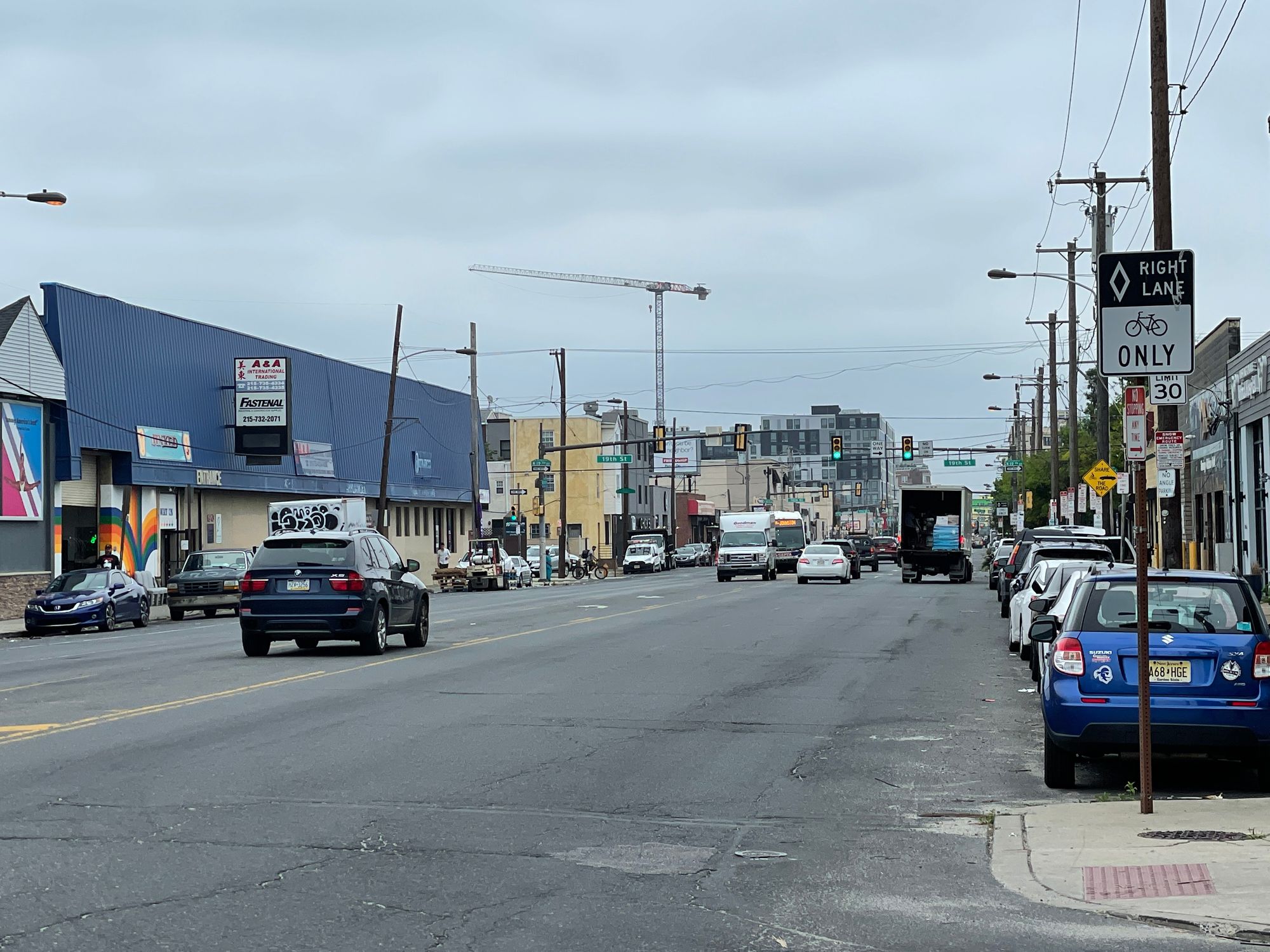
There is a road in Philadelphia.
Like many American roads in many American places, this arterial is in dire need of repair — has been for more than a decade. This particular road is the dividing line between South Philadelphia and Center City.
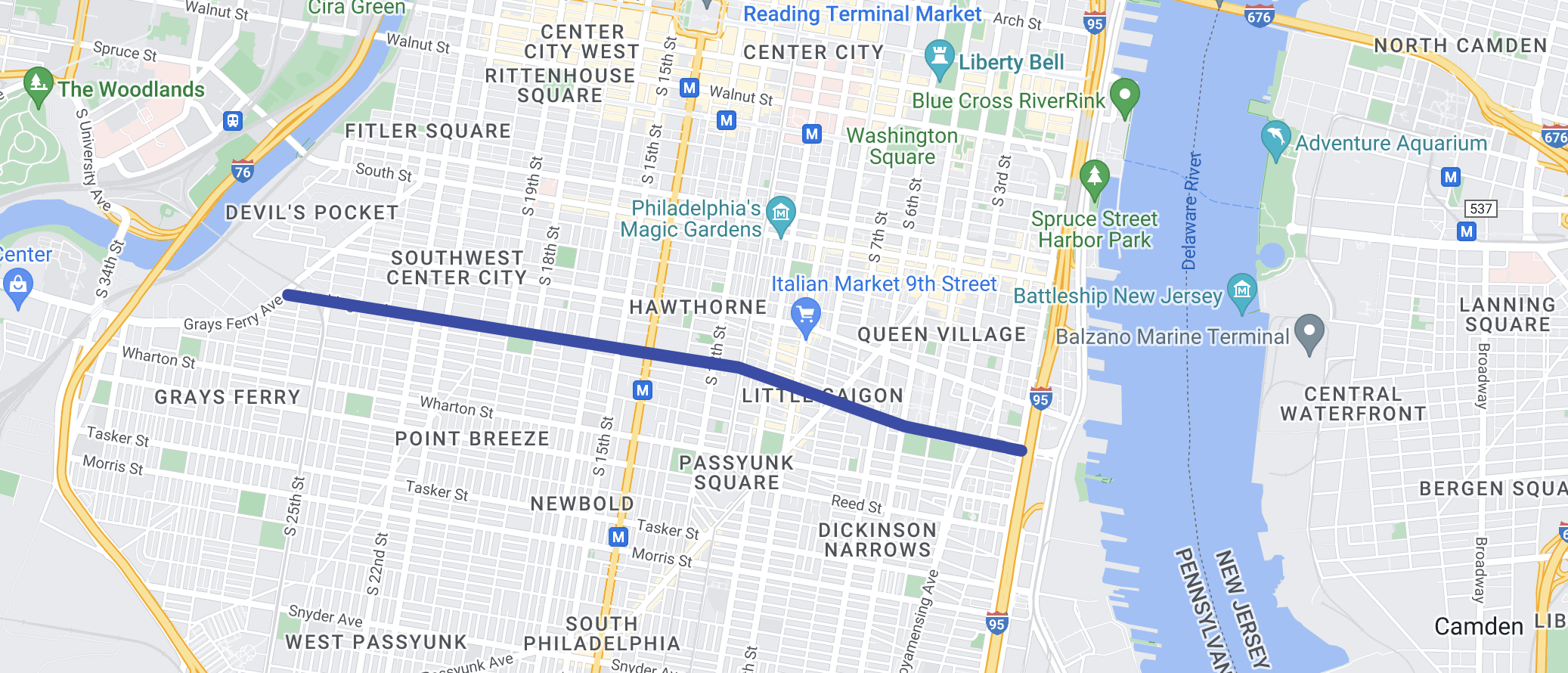
It’s one of the primary ways to get between the city’s two rivers and, thus, major highways. It’s one of the widest, mostly due to its historical purpose of moving industrial loads over its now-paved railroad tracks. I live two blocks from this road and cross it twice a day, often with my one-year-old daughter in tow.
After decades of neglect, the city of Philadelphia decided it was time to finally, mercifully repair and reimagine Washington Avenue. But what happened instead is a textbook case of living in urban America in the 21st century.
It’s a story of one man cynically stopping the hard work and the frustrating-but-fair compromise thoughtfully navigated by a community of city workers, parents, students, volunteers, and activists. But mostly, it’s yet another example of how American cities are seemingly no longer capable of accomplishing even the simplest of things. Things like repaving a two-mile stretch of road.
This is what happened to Washington Ave.
The State of The Avenue
To understand the urgency of changing Washington Ave, it helps to understand the utter state of disrepair and general anarchy that marks a trip down Washington Avenue today.
Another beautiful morning on Washington Avenue
— Carl Gershenson 🏘️ (@cgershenson) March 10, 2022
An NJ driver smashing into a city sanitation truck
@PhillyOTIS @CouncilmemberKJ @CMMarkSquilla pic.twitter.com/AomTwI3ulg
Washington Avenue was last repaved in 2003. The status quo and (as of this writing) the current state of Washington Ave is a road that holds five lanes of traffic, two lanes on each side with a center turning lane. To its north and south are mostly one-way streets in walkable, dense neighborhoods with (mostly) street parking.

While there are technically five lanes , cars are often double-parked to access the businesses that dot the avenue. Likewise, the potholes are at times so deep and so large that they effectively block an entire lane.
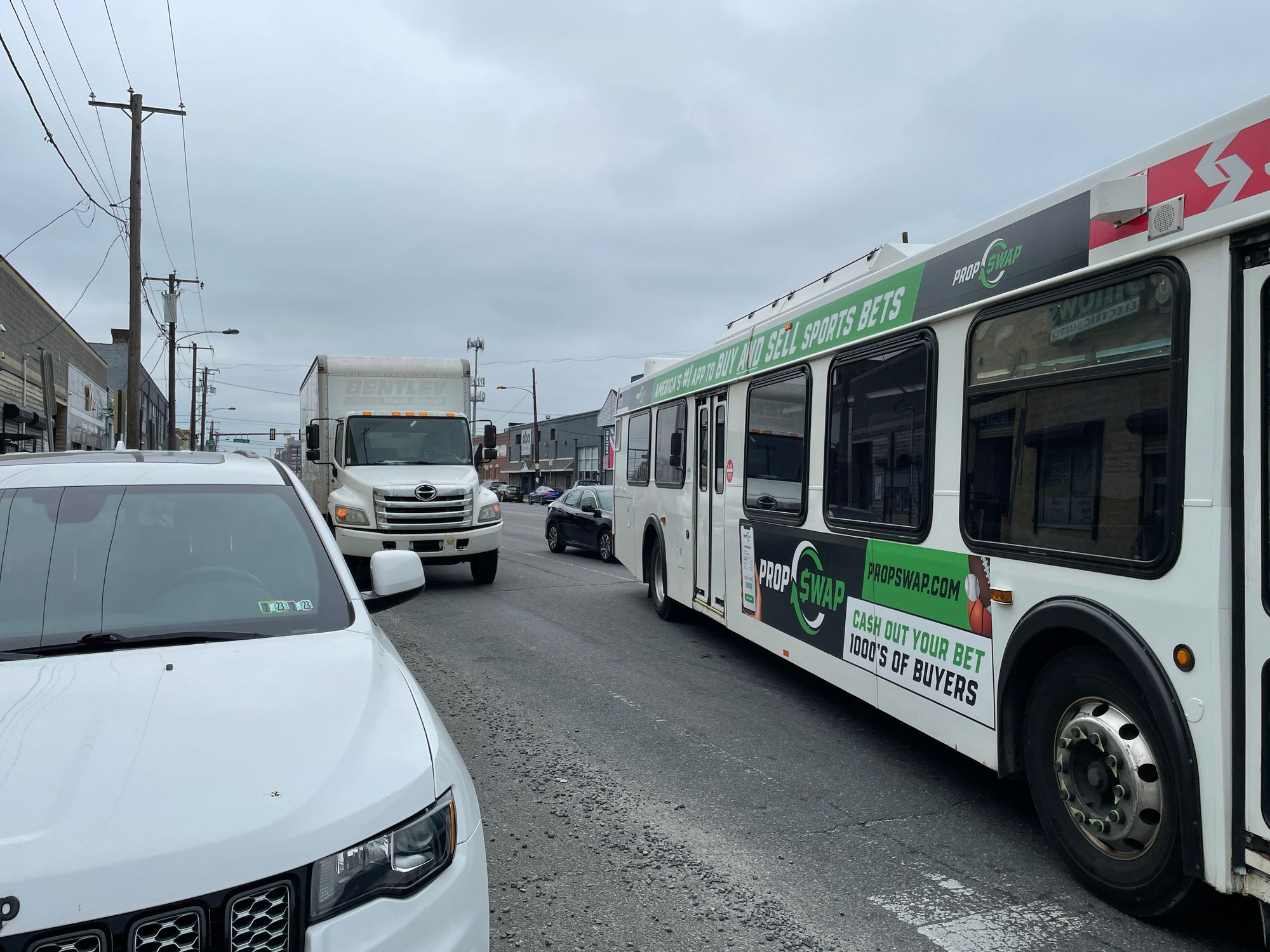
While there is technically a bike lane , it is not shielded from the traffic and most of the markers depicting the bike lane have faded with time. The few bikers that do venture biking the avenue are exposed to passing cars and vulnerable to a doubled parked car suddenly opening their door or blocking your path. It is sparingly used.
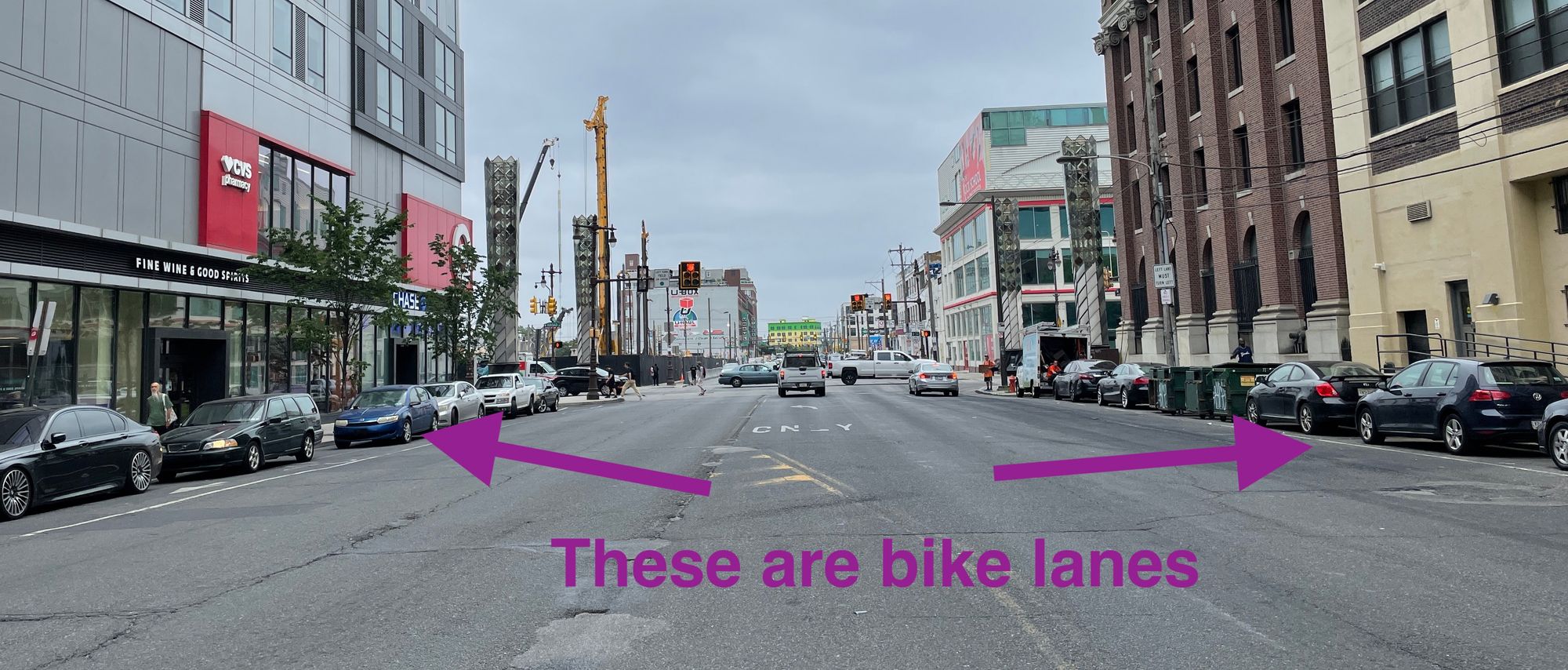
And while there is _ technically _ a sidewalk , pedestrians often choose a surrounding street instead as Washington Ave is routinely blocked by cars parking on the sidewalk blocking access. Or by dumpsters and mounds of trash that businesses discard. Or by the total lack of tree cover that makes the avenue a miserable walk in the summer heat.

It is part of the city’s “High Injury Network” — the 12% of roads that are responsible for 50% of the city’s total fatal and serious road injuries. Washington Avenue is not a fun trip whether you’re walking, biking, or driving. If there’s one thing residents can agree on, it’s that the road needs some attention.
Time for a change
The city agreed, and in 2013 began conducting outreach and research.
The Philadelphia Office of Transportation, Infrastructure, & Sustainability (OTIS) got to work. In 2013, it began the process of collecting feedback. From the city’s materials:

At the tail end of this process of study after study and numerous public input meetings, COVID struck. But the city admirably pressed on to gather additional feedback from residents. The question posed was simple: Which of these three options would you most prefer for Washington Avenue?:
- Option #1: A (mostly) 4-lane option
- Option #2: A “mixed” lane layout where sections ranged in width
- Option #3: A (mostly) 3-lane option
(Note the lack of a 5-lane option. The city wasn’t even considering keeping the status quo.)
The city’s outreach to learn the preference of the residents included…
- 37 meetings with 26 registered community organizations and civic associations.
- 5,458 survey responses across four languages.
- 5,400 postcards mailed to homes surrounding the avenue.
- 80% of the 187 businesses judged to be impacted by parking and loading changes.
The results? Residents overwhelmingly preferred the 3-lane options (the city says this number was “74%-67%” of residents). Furthermore, the second-to-lowest ranked goal of any repaving from nearby residents was “quick drive times”.
The consensus was clear: those who lived around the avenue wanted fewer lanes for cars and more room for bikes and people. At this moment, the city was proud of this outreach. OTIS itself called its outreach “extensive” and here is Philadelphia Mayor Jim Kenney boasting how many people participated in a range of formats and channels:
Even though they couldn't meet with community members in person, @PhillyOTIS received input from 5,600 residents about repaving and improvement plans for Washington Avenue.
— Jim #VaxUpPhilly Kenney (@PhillyMayor) July 17, 2020
They shared their feedback through a survey, phone calls, texts, emails, and mail. https://t.co/gng1QkhJtY
“Equity”
That’s seven years (!) of study and outreach and an undeniable majority opinion. Case closed, right? No.
As COVID stretched on, the repaving was delayed. In 2021, OTIS shared that they were reopening the analysis and feedback process. (The same one they had begun in 2013 and bragged about being so thorough.)
In a July 18, 2021 Philadelphia Inquirer article, OTIS first blamed the pandemic. From the piece:
The project delay is due to the need for “review, coordination and contracting” of a number of construction and repair projects underway at the same time amid a backlog of work from last year’s COVID-19 shutdown, Mike Carroll, the city’s deputy managing director for transportation, said in a statement.
But something else was going on. Someone, somewhere had insisted the process reopen in the name of “equity”. Eventually, it became public: the city was hoping to ease the perception that they had only reached out to new or wealthier residents. Which, given the history of urban planning in America, is understandable. From a Feb 2022 WHYY article:
“People who are Black and brown, people who are in lower-income situations — there’s a pattern in transportation — only get asked or spoken to after decisions are made,” Carroll said in an interview after the decision was announced. “Anyone who knows anything about the history of urban transportation cannot argue with that fact. And so in a profound way, this was replicating that process.”
Washington Avenue cuts across several neighborhoods, some historically Italian, some historically Black, some historically Asian, and all feeling various pressures and tensions of changing demographics from an influx of new residents.

OTIS’ statement from a later release:
In 2021, the City responded to requests from community and Council for more engagement particularly in the Point Breeze and Grays Ferry neighborhoods, where low-income and residents of color have been historically underrepresented in city planning decisions.
There are a few issues with this framing:
Problem #1 - At no point were the identities, organizations, or even the quantity of these “requests” demanding an updated process ever shared. (Right to Know requests have been heavily redacted).
Problem #2 - The outreach was not solely digital, which may favor wealthier households. There were phone calls and postcards sent to all homes within a two-block radius of the avenue. Local businesses were physically visited. OTIS visited 26 community groups. To say nothing of the meetings stretching back to 2013.


Problem #3 - Point Breeze and Grays Ferry (the neighborhoods mentioned explicitly in the justification for reopening the process) are largely covered by 19145 and 19146. Residents in those zip codes still preferred the 3-lane options.

Problem #4 - The very gentrification that this hopes to prevent… has been occurring anyway in the previous decade! By leaving the avenue the same and protecting the status quo, it ensures that the same set of circumstances that lead to the massive increase in local property values stays the same while the road remains unsafe.
Problem #5 - This framing assumes that no longtime residents or non-white residents prefer safer biking, walking, and driving on Washington Ave. It supposes that only newer residents somehow benefit from any changes to the road.
As a supporter of the 3-lane option (and Point Breeze resident), I was furious and began to ask around. What was once an open, public, and transparent process was now moving underground.
OTIS began “quietly meeting with local Registered Community Organizations (RCOs), residents, businesses, and advocacy groups.” These were closed-door, invite-only meetings to gather additional feedback — likely an understandable attempt to soothe concerns with their plan.
These meetings were publicized via backchannel to existing interest groups, which meant you had to already be somewhat politically connected to be aware of them and to attend them. There was no way to find out where these meetings were unless you knew someone who knew someone. The guest list was never shared publicly. And those who had weighed in during the previous outreach and had no means of finding them out.
This meant, of course, that those happiest with the status quo would be the most likely to be aware and attend. It also meant the new meetings would likely not address any concerns of reaching residents left out of the previous process.
I found the location of a meeting and attended it on November 9, 2021. When I entered, I was signed in by staff that immediately handed me a flyer for a protest against the 3-lane plan. There were 20 or so residents in chairs who were never asked to identify themselves, though I recognized several from community meetings in the past — again, these were people who had some (however minor) existing affiliation and local influence and power.
Representatives from OTIS said they were there to listen, and before they could finish addressing the room, two or three outspoken residents shouted over them demanding the road be kept the same. One of those residents owned a car body shop that routinely parks cars on the sidewalk and claimed to be speaking for businesses on the avenue.
A generous reading of the room would have had opinions split. After some order was restored, attendees were asked to mark up maps of Washington Avenue with their thoughts.

But OTIS also shared another note: they were collecting paper surveys to help reach residents who may not have been notified by any online outreach. Again, the fact that there was no offline outreach is not true according to OTIS’ own analysis.
The closed-door working group created a paper survey. Though the survey was never publicly shared and its source remained opaque to most who took it, pro-3-lane activists took the new rules at face value and began circulating those paper surveys in neighborhoods to help make the case that most residents, no matter their race or economic status were in favor of 3-lanes. I was one of those people who went door-to-door in my neighborhood in 19146 and camped out at local bars collecting surveys.
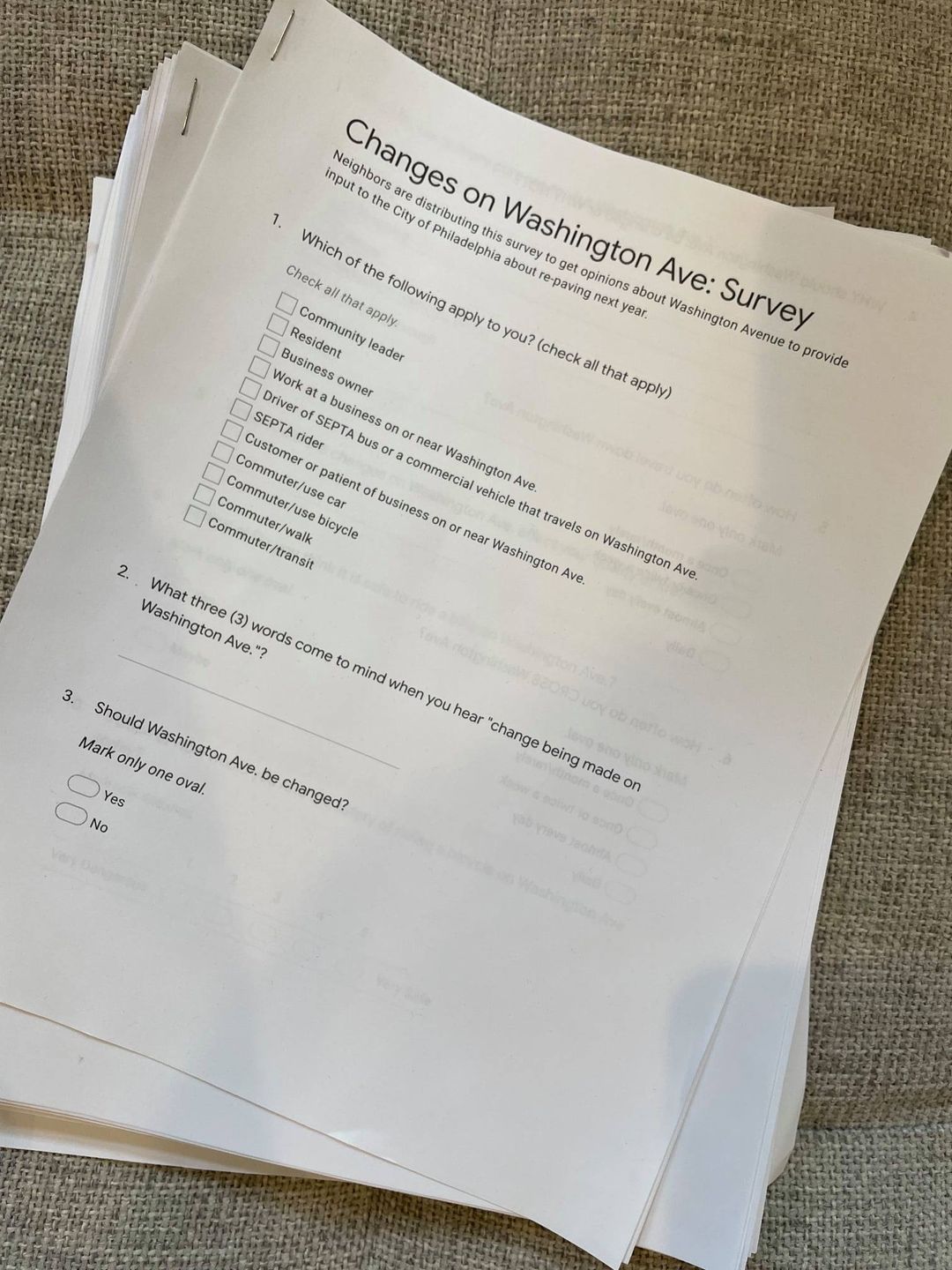
On November 30th, at the next meeting, we delivered 750 surveys all in favor of the 3-lane plan. The effort was the hard work of dozens of volunteers who set up drop boxes, went door to door, and attended events. 790 surveys were received in total. If all of the 40 remaining were against the 3-lane option, that meant 95% were supportive of the new plan.
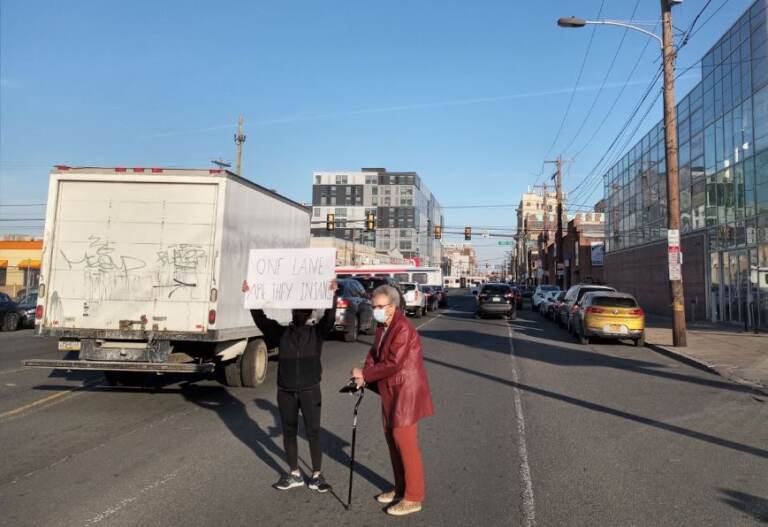
If you’re keeping track at home, the 3-lane option remains undefeated after engagement in every conceivable forum and format.
Again, by the city’s own admission: “The survey showed most respondents were still in support of the City’s proposed changes [to three lanes].” (source)
Additionally, two new dueling online petitions surfaced.
- 2,677 signatures including representatives from schools around the avenue supported the 3-lane option. These signatures were meticulously checked for duplicates and signatories that were outside of the affected zip codes.
- 1,868 signatures opposed the changes. Even if we assume all signatures were people that lives in affected zip codes, yet again, the 3-lane option proved the most popular.

Having the 3-lane option win every medium, every forum, and every survey — The city closed its second round of process and said it would announce a new plan. Any residents who had issues with the plan had a chance to make their voice heard.
If one takes the allegation that a process was not inclusive at face value, a series of in-person meetings with hand-picked participants, combined with extensive paper surveys hand delivered door-to-door should have found some sort of hidden majority of residents overlooked by previous outreach efforts.
The “Mixed” Option and Moving the Goal Posts
On February 5th, 2022, OTIS announced that the 3-lane option was dead. As was any hope of a reverse course to the 5-lane option (hold this thought). They would be choosing between the 4-lane and the “mixed” option, backtracking from its own recommendation and “equitable” outreach process. The most popular option was off the board, and there was no evidence that this was the preferred outcome of any group, by any segmentation.

The city then announced on March 1st that it would be going with the “Mixed” option, which varied the widths along the avenue. It also hosted a contentious open house where OTIS staff members presented their plan to shouts, boos, and protests from all sides of the issue.
It's a packed house here at the @PhillyOTIS unveiling of the Washington Avenue plan. @CMMarkSquilla & @CouncilmemberKJ are here. pic.twitter.com/KaELFGwnRX
— Bicycle Coalition of Greater Philadelphia (@bcgp) March 1, 2022
3-lane advocates felt duped. And 5-lane advocates felt that the city ignored them.
But at least, after a decade of outreach, there was a resolution and a bit of a compromise. At the end of the meeting, the next step was clear: All that was left to do is to have City Council members approve the changes in parking and loading zones, and then the city could repave using the new mixed lane format. OTIS was adamant that the repaving was happening in 2022, regardless of whether a specific plan was approved.
You can probably guess what happened next.
The Pocket Veto

Washington Avenue runs through the districts of Councilmember Mark Squilla (the purple line) and Councilmember Kenyatta Johnson (the orange line). Both would need to submit the changes to parking and loading zones via legislation. As of March, this seemed likely. After the compromise plan was announced Councilmember Johnson said in a city statement (emphasis mine):
“ I want to thank OTIS for taking the additional time to hear from all voices in the community concerning Washington Avenue. I always wanted to make sure that the public comment process on Washington Avenue was diverse and inclusive and reflected the views of all residents, including the business owners and long-term residents…”
With the City Council’s summer recess approaching in June 2022, and a repaving happening sometime this year, there was a tight window to submit the legislation. Councilmember Squilla submitted for his side. And Councilmember Johnson then… did nothing. He did not submit the required legislation.
There was no statement or reasoning given until approached by the media. But the implicit soon became explicit: Councilmember Johnson seemed to have no intention of ever hearing the concerns of his own constituents. In an interview with KYW, our local news radio station:
“Where I’m at right now is supporting the five-lane plan with traffic calming measures,” Johnson said in an interview this week.
The 5-lane plan. The one that was off the board for months, that no majority in any forum had expressed support for.
Johnson didn’t suggest an alternative greater than some speed bumps and traffic light timings.
He insisted on a more inclusive process, got it, and then did what he wanted anyway by hand choosing an option that was dismissed a year earlier. If equity concerns were the reason for the delay, then surely the new compromise plan after private meetings with long-time residents would address his concerns. The city (again, understandably) attempted to address all perceptions of inequity, adjusted the final outcome, and still couldn’t get the councilmember to play ball.
But not only was Johnson refusing to submit the legislation, but he was also choosing an approach that wasn’t even in consideration by the city: maintaining Washington Avenue as 5 lanes.
We thank @CMMarkSquilla for the introduction of parking and loading legislation within the first council district. It is our hope @CouncilmemberKJ will introduce an amendment to Squilla's legislation soon to include the second district as well.
— OTIS Philadelphia (@PhillyOTIS) May 27, 2022
So let’s recap:
- Residents in every available forum across nearly a decade voiced a desire to reduce the width of Washington Avenue.
- The city itself came to the same conclusion.
- Concerns about an equitable process were raised.
- The city then asked for more feedback in formats that included long-time residents.
- The city added another lane and adopted a “mixed plan” instead of the 3 lane options as a compromise.
- Rather than submit the legislation for the compromise “mixed plan” Councilmember Johnson chose to do nothing.
The ten years of engagement were a waste. Thousands of hours of city workers’ time at the taxpayer’s expense were wasted. And, what is most frustrating to this resident, hundreds of hours of well-meaning, civically minded residents on all sides of this issue were rendered moot because of the choice of a single elected official — and we’re not getting a true explanation as to why.
Thousands of people invested time and energy in helping to decide Washington Ave's future. Every time, a vast majority of those responding said that they wanted the road made safer and narrowed. Exactly one man overturned all of this feedback and decided it stays dangerous.
— Daniel Pearson (@DPearsonPHL) May 26, 2022
If you made it this far, you may be thinking, “I mean, this is just a single road, dude. Chill out.” But that’s the point. Repaving roads should be the easy stuff. Philadelphia has bigger issues than a single road:
- Weeks before this writing, Philadelphia made international news for amass shooting on one of its most popular streets. There were 557 fatal shootings in 2021, the highest ever recorded.
- Philadelphia has an illegal dumping issue that it is partly tackling by… conducting a study:
“I understand the public’s frustration, and we are looking at many options criminally, many options civilly, to bring people to accountability,” said Lewis, who chairs the city’s interdepartmental committee on illegal dumping.
“There are a group of 20 professionals sitting around trying to figure this out, in addition to everyone we work with. We’ve all been working on this problem for a number of years.”
- Many Philadelphia schools contain asbestos and lack air conditioning, leaving many schools to shutter or require costly upgrades and repairs.
- Local pools and libraries remain understaffed and in poor condition, leaving children few options for summer recreation.
True “equity” would be acting boldly to address all of our issues, from a single road to the issues above. Something as simple as a road being repaved should not require a full decade of analysis. And if it does require all those resources, let’s make sure they actually impact the final decision!
Examples of ineffective and wasteful urban governments like this play out all around the country. Three recent examples:
- In 1900 to 1904 New York City opened 28 subway stations. It took 17 years to open the three Second Avenue Subway stations. (source)
- Upgrading a single bus lane and the underground utilities cost San Fransisco $349 million. (source)
- A backup in the Port of Long Beach was only mitigated when a single entrepreneur took matters into his own hands to conduct a review that the government should have tackled. (source)
It’s the same reason most Americans can agree to basic gun reforms, or healthcare policy, or any of the hundreds of other vexing issues and be ignored at every turn by elected officials.
Why would any of the thousands of citizens, community groups, or activists that participated in the process ever engage with the city ever again if they know that this is the likely outcome? For my fellow Philadelphians reading this, we don’t have to be yet another American city stymied by small imaginations.
It starts with paying attention locally. In Philadelphia windows, Ukrainian flags outnumber signs about local issues. 23% of residents voted in the 2019 primaries, the last time city council members were up for election.
Elections matter (and little else). Know that any “engagement” or process or study done on behalf of the city is pure theater. The city is running the same playbook for the Ben Franklin Parkway. Why would anyone participate in the ultimate decision will often come down to the influence of an unelected few have on a single elected official? In Philadelphia, change happens by replacing, not engaging with, ineffective leaders.
Ending councilmanic prerogative. Above I stated that the two councilmembers would have to introduce legislation to move this forward. That’s not entirely true, it’s just a Philadelphia tradition of “councilmanic prerogative” the idea that councilmembers defer to one another in matters concerning their district — giving each member absolute power over developments in their district.
Councilmember Johnson is awaiting (re)trial by the FBI for accepting money in exchange for approving a proposed development in his district. Another councilmember had to step down in January after being convicted of similar bribery charges.
This is not a law, the mayor or any of the other 16 members could end this — but they don’t. It’s a gentleman’s agreement in order to maintain a series of ineffective fiefdoms where one representative can overrule the preferences of entire swaths of the city.
—
This is not democracy, it is not American ingenuity. It is corruption and cynicism — often wrapped in a cloak of social justice or grievance politics. It’s a series of officials who skim their share of power and money and don’t care about the impact on residents. And it’s the desires of a handful of outspoken and well-connected residents overruling the needs of the many after an exhaustive 10-year process.
The only way to overcome this national malaise is to replace the officials who rest comfortably because of apathy, and it starts locally, wherever you are reading this.
we are are being ground into dust by needless friction imposed by one clique of rent seekers or another.
— William B. Fuckley (@opinonhaver) January 19, 2022
opposition to this is increasingly becoming the main axis of my personal politics.